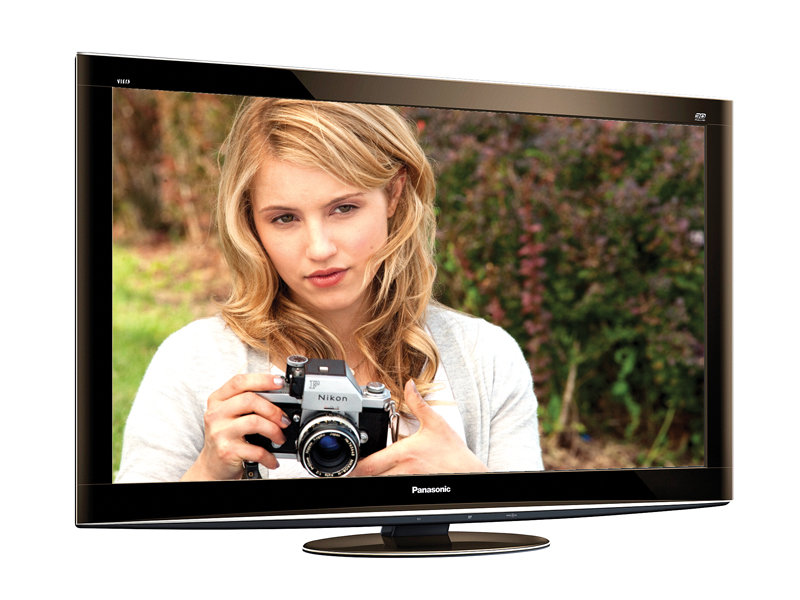Why you can trust TechRadar

Kicking off with 3D, the TX-P46VT20B quickly confirms that it's the leader of the 3D pack, setting such a high standard for a debut technology that it won't be at all surprising if rival LCD screens struggle to match it, even with second-generation products.
The single biggest reason for this is the TX-P46VT20B's almost complete freedom from crosstalk noise. This double ghosting issue plagues every single LCD TV to some extent, diminishing the sharpness and depth credibility of 3D images, even on those that handle it the best, not to mention giving you a pretty nasty headache if you're not careful.
So having crosstalk appear only extremely subtly and once in a blue 3D moon on the Panasonic TX-P46VT20B is a joy, enabling you to both watch 3D for longer periods of time with no ill effects and appreciate much better the whole point of active 3D's full HD resolution.
Leaving a chink of hope for LCD 3D TVs is the fact that Panasonic's first generation of 3D plasma TVs – including the TX-P46VT20B – do suffer a pretty serious reduction in brightness when you've got Panasonic's active shutter 3D glasses on. So much so that while black levels look astoundingly deep, some shadow detail can be squeezed into dark oblivion while an occasional dark colour tone can look a bit forced.
While the reduction in brightness could present a problem for people with bright living rooms, though, for most people the trade of brightness for crosstalk will be one they'll be only too eager to make.
The main gripe about the TX-P46VT20B's 3D performance concerns the 3D glasses. The lenses are much too narrow, allowing too much light and ambient room information to enter your eyes along with the 3D images. This may require you to slide them down to the end of your nose to get the right angle from your eyes to the TV screen, which is just silly.
Panasonic has been keen to stress that the technologies introduced to the TX-P46VT20B to aid its 3D performance also boost its 2D efforts. These are more than just idle boasts: the TX-P46VT20B is the finest 2D picture performer Panasonic has made to date, which is really saying something.
Sign up for breaking news, reviews, opinion, top tech deals, and more.
Particularly excellent in 2D mode is the TX-P46VT20B's black level response. So rich, deep and natural are the set's black levels, in fact, that it's tempting to think that the filter behind the new Infinite Black Pro technology is the most direct result yet of Panasonic's 'knowledge-sharing' deal with Pioneer – the brand responsible for the legendary Kuro plasma TVs that still haven't been beaten for contrast two years after they were withdrawn from the TV market.
The TX-P46VT20B's black levels still aren't as good as those of the Kuros, but they're the best around among TVs you can still buy, especially if you factor in the way deep blacks retain shadow detail and can sit right alongside punchy bright image content. This is a combination of skills LCD TVs can only dream about.
The TX-P46VT20B's colours represent an improvement over previous Panasonic sets, and other models lower down Panasonic's current range. Reds, in particular, are much richer and, well, redder than Panasonic's previous slightly orange efforts and this improvement also filters through into better skin tones and a generally more dynamic and balanced palette.
The TX-P46VT20B's colours are reasonably punchy in 2D mode too; no match for the histrionics of a typical edge LED or direct LED LCD TV, perhaps, but strident enough to really emphasise just how much brightness the set loses when you don your 3D glasses.
Also excellent about the TX-P46VT20B's 2D pictures is its fine detail response, as it effortlessly reproduces the finest of picture information from top quality Blu-rays. What's more, the set's talent for reproducing detail in dark areas means this clarity remains consistent; you aren't suddenly faced with a sense of hollowness during dark scenes like you can be on many LCD TVs.
Motion is completely free of blur, meanwhile, and, finally in the plus column, a combination of Panasonic's NeoPDP technology and its most powerful scaling engine means that standard-definition material is sharp and clean, and retains colour tone much more satisfyingly than you see with many cheaper or older Panasonic plasma sets.
The few problems include some very minor dotting noise over skin tones if they're crossing the screen quickly and some apparent momentary colour lag at times if you're watching 50Hz, though this can be removed via the Intelligent Frame Creation circuitry.
Overall, though, the positives of the screen, especially as a purveyor of active 3D and Blu-ray, far outstrip its minor flaws.
Current page: Panasonic TX-P46VT20B: Picture quality
Prev Page Panasonic TX-P46VT20B: Features Next Page Panasonic TX-P46VT20B: Sound and value
John has been writing about home entertainment technology for more than two decades - an especially impressive feat considering he still claims to only be 35 years old (yeah, right). In that time he’s reviewed hundreds if not thousands of TVs, projectors and speakers, and spent frankly far too long sitting by himself in a dark room.
